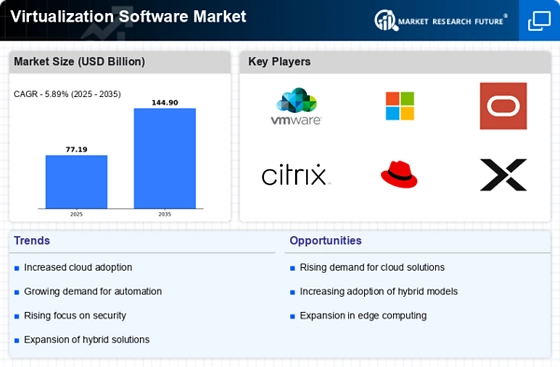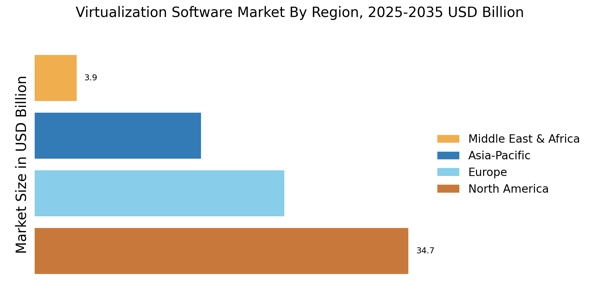Expansion of Remote Work Trends
The Virtualization Software Market is being propelled by the expansion of remote work trends. As organizations adapt to flexible work arrangements, the need for secure and efficient access to corporate resources has become paramount. Virtualization software facilitates remote access to applications and data, ensuring that employees can perform their tasks from any location. Recent surveys suggest that over 70% of companies are investing in virtualization technologies to support their remote workforce. This shift not only enhances productivity but also fosters employee satisfaction. Consequently, the virtualization software market is likely to see sustained growth as businesses continue to embrace remote work as a long-term strategy.
Rising Demand for Cost Efficiency
The Virtualization Software Market is experiencing a notable surge in demand for cost efficiency among enterprises. Organizations are increasingly seeking solutions that allow them to optimize resource utilization and reduce operational costs. Virtualization enables multiple virtual machines to run on a single physical server, which can lead to significant savings in hardware expenses. According to recent data, companies that implement virtualization can reduce their IT costs by up to 30%. This trend is particularly pronounced in sectors such as finance and healthcare, where budget constraints are prevalent. As businesses strive to enhance their bottom line, the adoption of virtualization software is likely to continue growing, thereby driving the market forward.
Integration of Advanced Security Features
The Virtualization Software Market is increasingly integrating advanced security features to address rising cybersecurity threats. As virtualization becomes more prevalent, the potential vulnerabilities associated with it have also come to the forefront. Organizations are seeking virtualization solutions that offer robust security measures, such as encryption and access controls, to protect sensitive data. Recent findings suggest that businesses implementing advanced security features in their virtualization software can reduce the risk of data breaches by up to 40%. This heightened focus on security is particularly relevant in sectors like finance and healthcare, where data protection is critical. As the demand for secure virtualization solutions grows, the market is expected to expand accordingly.
Growing Need for Scalability and Flexibility
The Virtualization Software Market is characterized by a growing need for scalability and flexibility among enterprises. As businesses expand, they require IT solutions that can easily adapt to changing demands. Virtualization provides the ability to scale resources up or down based on workload requirements, which is particularly beneficial for companies experiencing rapid growth. Data indicates that organizations leveraging virtualization can achieve a 50% faster deployment of new applications compared to traditional methods. This agility is crucial in today’s fast-paced business environment, where the ability to respond quickly to market changes can provide a competitive edge. Thus, the demand for scalable virtualization solutions is likely to drive market growth.
Increased Focus on Disaster Recovery Solutions
The Virtualization Software Market is witnessing an increased focus on disaster recovery solutions. Organizations are recognizing the importance of maintaining business continuity in the face of unforeseen disruptions. Virtualization technology offers robust disaster recovery capabilities, allowing businesses to quickly restore operations after a failure. Recent statistics indicate that companies utilizing virtualization for disaster recovery can achieve recovery times that are significantly shorter than traditional methods. This capability is particularly appealing to industries that require high availability, such as telecommunications and e-commerce. As the need for reliable disaster recovery solutions intensifies, the virtualization software market is poised for growth, driven by this critical demand.


















Leave a Comment